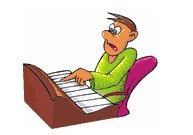Falling to a Piano Key
Home » Read Piano Notes » Falling to the Piano Key

One may wonder why we have to discuss such a simple issue as falling to the piano key.
And I say that falling to the key is too often taken for granted.
As we progress with our piano course we will notice that by dividing this action of falling to the key to three little steps we can gain awareness over these
simple actions and spare ourselves lots of stress and improve the sensitivity of our playing.
The art is in the small details.
"You are the music while the music lasts. ~T.S. Eliot".
Today I would like to talk more about how we can control the sound of the piano. We'll talk about the way the hand has to move toward the key and we'll basically extend the story of the first piano lesson.
We're going to focus on two different piano techniques in here.
The first one is the Whole Arm Technique.
This piano technique was developed in the romantic period as the piano became closer in shape and technique to the pianos exsiting today.
The big advantage of the new piano, as opposed to the clavichord and Cemballo's, is its ability to produce a wide rage of dynamics.
So it is now possible for the first time to produce more power, more loudness by using the weight of the whole arm.
Before, we could maybe try to do it but the piano wouldn't respond to it as it would later on.
So before that time people were using the Active Fingers technique.
Instead of using the weight of the whole arm they would keep the hand stable and loose and concentrate on moving each and every fingers seperately.
But let's start with the whole arm technique.
The Whole Arm Technique
This Piano technique is based on three main actions that occur when we press a piano key. (All three actions occur for a split of a second).
2. We fix our hand on the key: Otherwise we have no control on the tone pressed. Our hand should not be stressed though. Sometimes I imagine as if
I'm slowly drowning to the key.
3. Then we lift our finger(s) - If we leave our finger(s) too early it creates pauses between the notes which bother the musical idea. If you leave it too late,
you can't play fast enough.

| The key on falling to a piano key is to be loose - No stress involved |
Remember that gravity is working on our side, so there's no use pushing the key. It's enough to fall to it.
It's important to realize that once you pressed a key you can't do anything in order to control its sound.
You basically have to loosen you wrist and let it go.
People often think that the hardest thing in life is letting go.
We're great in working long hours but some of us find it so hard to simply do nothing.
We're always busy with doing something. Thinking about something. Going somewhere.
This is where music helps you to learn to simply rest. Do nothing, be in the NOW.
An E.D. Exercise on Falling Correctly to a Piano Key
Every day five minutes remember?
Place your right hand on the middle C position.
Fall to the piano key from above, fix your first finger on Middle C without causing any stress (Making a movement from the tip of the finger toward the pillow helps!),
And leave the key after two Counts.
Watch your hand. Is it round? If your hand is bended it might point out that you add some unnecessary energy in there.
Remember something important. Once you've touched the key your ability to control the sound is gone! So you can simply relax and go on to the next key, just like in life.
Let's say you've made a mistake. Next time do better, but stressing won't help for sure.
Then go up again freely. Determine a comfortable pace for yourself. After you've left the 1st finger fall again to the D key with your 2nd finger and perform the same action.
Continue this way all the way up to G and back. Keep up with a good pace. Breathe.. Work slowly and make sure your wrist is loose
Once you're done with this exercise you'll be fully aware of these actions and they'll become automatic. Stick with this exercise for a while.
The Active Fingers Playing on the Piano Key
So, as I explained before, as opposed to the whole arm technique we're going to only move each finger separately when using the active fingers playing on the piano key.
What we're going to do is position our right hand on the middle C position again and start climbing up to C to G and back.
This time we'll keep the hand position steady, we'll make sure the wrist is loose and that our hand isn't stiff.
We'll try to move the thumb only, then switch to the second finger and leave the thumb only once the second finger is pressed.
We'll continue that way by making sure we're loose and that we only move one finger at a time.
Before we'll drop a finger to a piano key we'll first raise it up in order to give it extra distance to go through in order to produce a clearer sound.
That's what we call ACTIVE fingers
I hope the video above will make this piano key lesson extra clear for you.
 Now that you know the concept behind falling to the piano key you can concentrate on learning how to read piano notes and go further with your piano technique.
If you want to become a better piano player you should definitely check out the Rocket Piano Ultimate Learning kit. Rocket Piano provides
an amazingly handy and effecive piano course on various issues such as reading piano notes, playing piano by chords, piano technique and more.
Now that you know the concept behind falling to the piano key you can concentrate on learning how to read piano notes and go further with your piano technique.
If you want to become a better piano player you should definitely check out the Rocket Piano Ultimate Learning kit. Rocket Piano provides
an amazingly handy and effecive piano course on various issues such as reading piano notes, playing piano by chords, piano technique and more.
You're going to love the way they work systemically with the help of their useful audio and video files that are short and to the point. By working
with Rocket Piano you basically guarantee that you'll become pro at reading piano notes (And the big bonus is you'll learn to play piano by ear as well).
Check out the Ultimate Piano Learning Kit of Rocket Piano Now!














